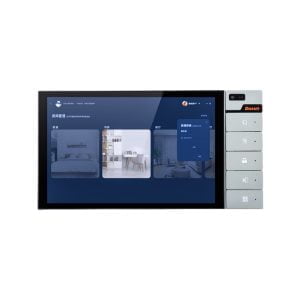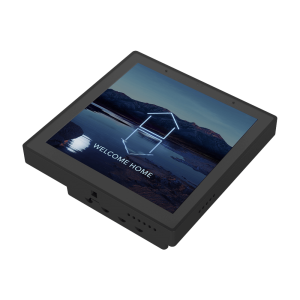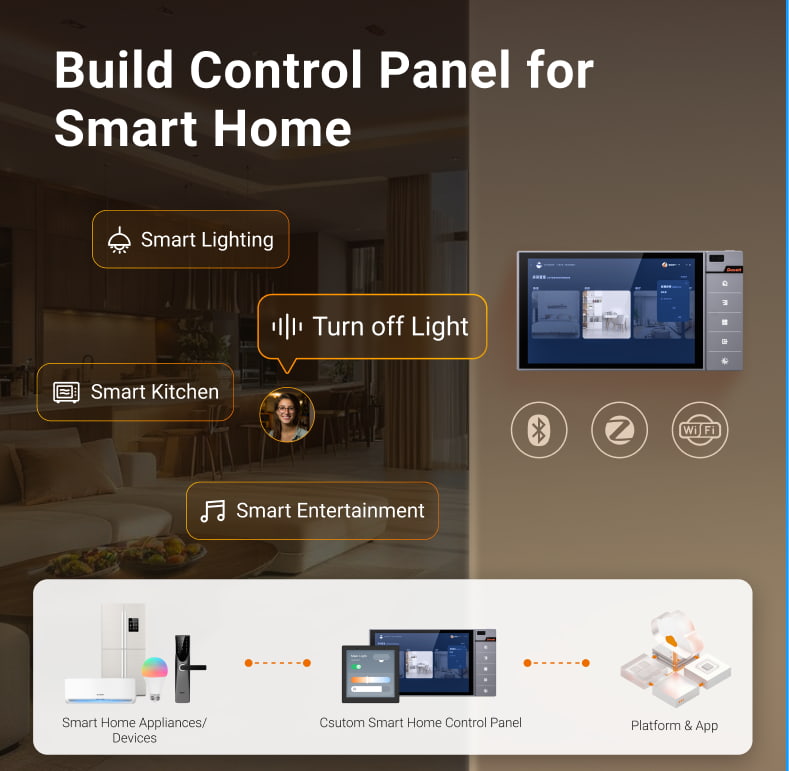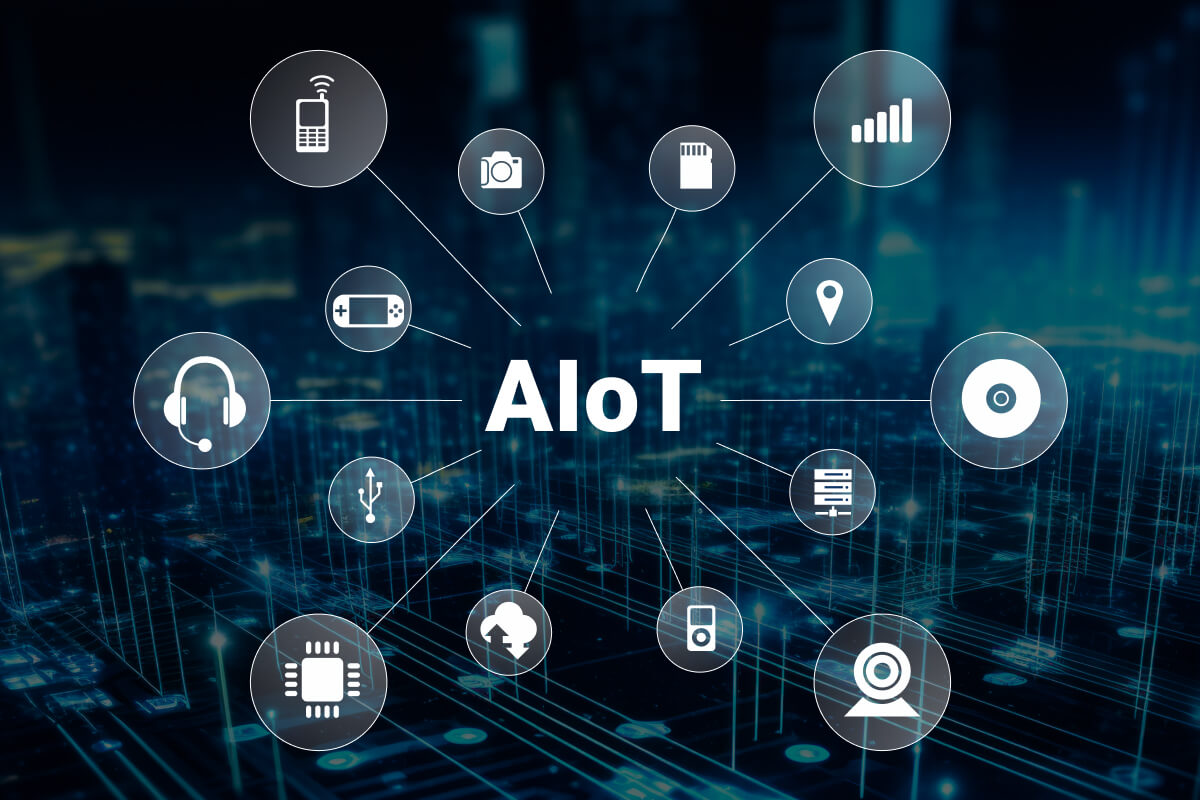In the rapidly evolving landscape of smart home technology, the development of a sophisticated Smart Home Control Panel stands at the forefront of innovation. According to Statista research, the number of connected smart home devices/sensors is expected to rise to 30.9B by 2025 worldwide. As the bridge between diverse smart devices and the seamless user experience, a well-developed control panel can transform a mere house into an intelligently interconnected living space. For leading smart home brands, this represents an unparalleled opportunity to capture market share and enhance user satisfaction. By integrating advanced communication protocols, intuitive interfaces, and adaptive automation, your brand has the potential to redefine how consumers interact with their living environments, ensuring convenience, security, and efficiency like never before. This article will bring smart home brands up to speed with everything need to know about building smart home control panel.
What is a Smart Home Control Panel?
A Smart home control panel is a data visualization tool that plays a crucial role in the smart home solutions and ecosystem. It organizes, transforms, and presents the collected data from IoT devices in a visually accessible format.
The main function of a smart home control panel is to showcase real-time and historical insights into smart home data for easy monitoring and decision.
These smart home control panels often feature various elements, such as charts, graphs, and numbers to represent data understandably.
Why Build a Smart Home Control Panel?
In the ever-expanding realm of smart home technology, the development of a smart home control panel is essential for any forward-thinking brand. This pivotal interface allows for centralized control and management of diverse smart devices within the home, enhancing overall user experience. By facilitating seamless interactions between various devices—from smart thermostats to security cameras—control panels serve as the cornerstone of an intuitive and automated home environment.
Furthermore, a smart home control panel ensures compatibility and interoperability among multiple devices and brands through its support for a range of communication protocols. This flexibility not only caters to current consumer needs but also positions your brand as adaptable and future-ready, crucial for customer retention and market expansion. Additionally, it opens avenues for incorporating emerging technologies and expanding your product ecosystem without alienating existing users.
Moreover, integrating a control panel enhances not just functionality but also security, offering centralized surveillance and access controls. This meets the increasing consumer demand for homes that are not only smart but secure. In a competitive market, offering a control panel that promises convenience, security, and energy efficiency can significantly increase your product’s appeal and give your brand a distinctive edge. Investing in smart control panel technology is not merely an enhancement of user experience—it’s a strategic move to solidify market presence and future-proof your brand in the smart home industry.
Things to consider when developing a Smart Home Control Panel
Developing a smart home control panel requires a well-thought-out approach. For instance, you need to pay attention to the following aspects when developing your control panel:
Types of Architectures
There are various approaches to developing a smart home control panel. However, based on the interaction between your IoT devices/sensors and the control panel, you can consider building one of the following types of smart home control panels:
- Cloud or Standalone smart home Panel: IoT devices/sensors connect to the smart home control panel through an IoT gateway or the cloud. The panel then communicates with the server rather than directly with the device.
- Embedded smart home Panel: The IoT devices/sensors are designed with their own control panels, often referred to as an embedded admin panel.
- Directly-Connected smart home Panel: The smart home device features an interface that allows for direct connection to an IoT control panel. Examples include Bluetooth-enabled apps receiving IoT device data.
IoT connection types
The functionality of a smart home control panel requires connection between the following architecture: IoT gateways, devices, and data systems. The type of IoT connection you require will vary depending on your goals and the scale of your ecosystem.
Here are the most popular IoT connection types available for smart home control panels:
- LPWANs: It provides long-range communication on tiny, durable batteries. Data transmission occurs in small blocks at a low rate.
- Cellular/LTE (3G/4G/5G): It provides convenient network connection but has high costs and power requirements. While 5G boasts high data transfer speed and low latency, it currently lacks global availability.
- Zigbee: It is a low-power, low-data rate wireless mesh network protocol. It operates on the IEEE 802.15.4 standard, making it ideal for smart home control panels due to its energy efficiency and ability to connect multiple devices over a short range. It is often combined with WiFi connections for extended coverage.
- Z-wave: It serves smart home control panels well with its low-energy consumption and robust mesh networking capabilities. Operating on different frequency bands from WiFi, Z-Wave minimizes interference, enhancing reliability for smart home devices..
- WiFi: It facilitates high-throughput data transfer. However, their downsides are power consumption, scalability, and coverage
- BLE: They are conventional short-range networks ideal for consumer IoT apps. BLE-enabled devices often work in synchronicity with smartphones. However, their limitation lies in requiring close proximity among connected devices.
- Ethernet: It provides a wired connection known for its reliability, low latency, and high-speed data transfer. It is ideal for smart home control panels needing consistent performance and security.
- RS485 wired connection type: It is a wired connection type known for its long-distance data transmission capability and reliability against electrical interference. Its noise immunity and data integrity make it suitable for smart home control panel connectivity.
Compatibility and integration
Ensure the control panel that you are building is compatible with a wide range of smart home devices and platforms, such as lights, thermostats, security cameras, and voice assistants. This means supporting multiple communication protocols like Zigbee, Z-Wave, Wi-Fi, and Bluetooth.
It should integrate easily with smart home platforms. This guarantees that devlelopers can integrate their smart home system to the device and reduce the time to market.
User experience design
The control panel should be intuitive and user-friendly. We recommend building a smart home control panel with clear icons, straightforward navigation, and responsive touch controls. This makes it easy for all household members to operate the system.
Additionally, building control panels with voice control assistants integration can further enhance accessibility, especially for users with mobility issues or for quick, hands-free operation.
MVP functionality and scalability
Design the smart home control panel with MVP and scalability in mind.
As smart home technology evolves, the control panel should be able to support the addition of new devices and technologies, without needing significant reconfiguration or complete overhaul of the existing setup. Support for firmware updates and modular hardware upgrades can help maintain MVP and scalability depending on user expectations and priorities.
Must-have hardware components/features to build a smart home control panel
Building a smart home control panel involves integrating various hardware components and features to ensure functionality, ease of use, and easy integration with smart devices. Here are the must-have hardware components/features for a smart home control panel:
Processor and Memory
A robust processor (such as ARM Cortex or x86-based) with sufficient RAM (at least 2GB is crucial for running the control panel’s operating system and handling multiple tasks simultaneously. This ensures quick response times and smooth operation, especially when managing numerous smart devices.
Touchscreen Display
A high-resolution touchscreen display provides an intuitive interface for users to interact with their smart home system. It should:
- Support a minimum resolution of 1280×800 pixels for clear visuals.
- Be large enough (4-10 inches) strike a balance between usability (navigation) and space efficiency.
Wireless connectivity
The control panel must support various wireless and wired communication protocols, including the following:
- Wi-Fi and ethernet: The control panel should support both to provide flexibility in installation locations and ensure reliable network connectivity. WiFi will also provide remote access to the control panel via smartphones or tablets. On the other hand, ethernet offers a stable and fast internet connection, especially in areas with poor Wi-Fi coverage.
- Bluetooth and Zigbee/Z-Wave: Enables control panel to interact with a wide range of smart home devices, such as lights, smart locks, speakers, and sensors, Zigbee/Z-Wave are known for their low power consumption and robust mesh networking capabilities.
- USB and expansion Slots: These allow for future-proofing the system, enabling the addition of new functionalities or external smart home devices.
Backup Power Supply
A smart home control panel should have a built-in battery to ensure continuous operation of the control panel even during power outages. PoE (Power over Ethernet) capability can provide a stable power source and network connection through a single cable.
Voice Control Integration
Smart home control panels must have built-in microphones and speakers for voice assistant compatibility like Amazon Alexa and Google Assistant. This provides hands-free control and accessibility of the smart home control panel.
Sensor Integration
You should incorporate sensors into your smart home control panel to allow for responsive automation. For example:
- Proximity sensors will allow the control panel to adjust its display brightness or wake up based on the user’s presence. This enhances user experience and energy efficiency.
- Ambient light sensors will automatically adjust the screen brightness for optimal visibility under varying lighting conditions.
Security Features
Your smart home control panel must integrate biometric authentication (facial recognition and fingerprint scanner) to ensure that only authorized users can access the control panel. It should also have hardware-based encryption to ensure that all data transmitted between the control panel and smart devices is secure from potential unauthorized access and cyber threats.
Mounting Option
Your smart home control panel must have flexible mounting options, such as wall mounts and desktop stands. This provides versatility in placement, ensuring the control panel fits easily into various home environments.
How to Develop a Smart home control panel with Dusun IoT
Smart home manufacturers can opt to outsource the production of smart home control panels for several key reasons. Primarily, outsourcing companies possess specialized skills and experience that enable the design and manufacture of high-quality control panels. These firms leverage up-to-date technologies and market trends thanks to their professional engineers and designers.
Additionally, outsourcing can be cost-effective, allowing smart home companies to reduce manufacturing and labor costs. These outsourcing partners often benefit from economies of scale, providing more cost-efficient solutions. Also, they can accelerate the product’s time to market, which is crucial in the highly competitive tech industry, giving a substantial competitive edge.
As a professional embedded hardware company, Dusun offers an exclusive line of touch screen control panels and sevices, including the ready-to-deploy DSGW-120 8-inch smart control panel, DSGW-130 4-inch smart control panel models and ODM services, designed to enhance your smart home solution through cutting-edge technology.
1. Secondary Development and OEM based on Dusun’s Control Panel
Dusun is known for its expertise in IoT (Internet of Things) solutions, including control panels for various applications. The DSGW-120 and DSGW-130 models have flexible features and scalability, which make them excellent for integration into your smart home control panel development projects.
- Connect Seamlessly: Enjoy versatile wireless connectivity options like ZigBee, Wi-Fi, and Bluetooth, ensuring your smart home devices communicate smoothly.
- Voice-Controlled Comfort: With built-in vocie module, microphones and speakers, your end user can command the environment with just the voice.
- Developer Friendly: Get access to comprehensive documentation and supportive resources for both DSGW-120 and DSGW-130, making secondary software development a breeze.
- OEM Capabilities: Expand your brand with our OEM options, perfect for businesses looking to integrate advanced smart home technologies.

DSGW-120 8-inch Smart Home Control Panel
- OS: Android 11;
- CPU: PX30; RAM: 2 GB, eMMC: 8 GB;
- 8-inch IPS touch screen
- Support Bluetooth 5.2, ZigBee3.0, Z-Wave, Wi-Fi; 1 * WAN/LAN variable port: 10/100 Mbps;1 * RS485 port;
- 1* Micro SIM card, support 4G LTE Cat1;
- 5 MP Panoramic depth camera; 1 * Speaker, 1 * Microphone;
- Lithium back-up battery(1,500 mAh);

DSGW-130 4-inch Smart Home Control Panel
- CPU: PX30; RAM: 1 GB, eMMC: 8 GB;
- OS: Android 11;
- 4-inch IPS touch screen;
- ZigBee 3.0; Built-in Wi-Fi Module (2.4GHz / 5GHz); 1 WAN/LAN variable port: 10/100 Mbps;
- 1 Speaker, 2 Microphones;
- Dimension: 86 x 86 x 40 mm (with base); Compact design for 86-Box.
2.ODM Smart Home Control Panel
Dusun IoT provides comprehensive ODM services to help smart home brands navigate every stage of developing control panels. This includes hardware design, kernel and driver development, and rigorous testing. Here are the steps involved in the ODM process with Dusun IoT:
- Requirement Analysis: Dusun IoT works closely with smart home brands to understand their specific requirements, including desired features, target market, and branding guidelines.
- Hardware design: Based on the identified requirements, Dusun IoT’s expert developers design the hardware architecture of the smart home control panel, taking into consideration factors like sensor integration.
- Firmware and kernel development: Dusun IoT’s experienced software/applications team develops the firmware and kernel to provide smooth operation and compatibility with different devices and protocols of smart homes. This involves rigorous testing to identify and address any potential issues or bugs.
- Driver development: Custom drivers are developed to communicate between the control panel and connected devices easily for smooth interoperability and maximum performance.
- Testing and quality assurance: The control panel undergoes comprehensive testing for functionality, reliability, and security validation. This includes unit testing, integration testing, and real-world scenario testing to simulate various usage conditions.
- Certification: Dusun IoT supports getting the necessary certifications, such as FCC, CE, and RoHS, to meet regulatory standards and market requirements.
- Production and manufacturing support: Dusun IoT supports the production process, including supply chain management, monitoring of the manufacturing process, and quality control to ensure delivery on time and with quality.
- Post-launch Support: Dusun IoT also performs continuous support and maintenance to address any problems or updates post-launch to ensure optimal performance and meet customer satisfaction.
Conclusion
Smart home control panels allow for better IoT assets management and control, easy data sharing, and straightforward data analysis. It also empowers smart home owners to discover insights that would be otherwise hidden and make more effective real-time smart home decisions.
The road from learning how to create a smart home control panel to building one is long and challenging. However, by leveraging Dusun IoT’s expertise and resources, smart home brands can efficiently develop and deploy control panels that align with their brand identity and meet the evolving demands of the smart home applications. So if you need to build a smart home control panel that will fit your unique needs, contact us today.
















